Effect of Working Fluid on Characteristics of Organic Rankine Cycle with Medium Temperature Geothermal Water
Abstract
1. Introduction
2. Geothermal Potential in Croatia for Electricity Production
3. Working Fluids for ORC
4. Case Study—Geothermal Power Plant “Lunjkovec-Kutnjak”
- Resource Classification: It belongs to medium-temperature geothermal resources, which do not have natural replenishment. To maintain the sustainability of the geothermal system, the exhausted geothermal fluid will be reinjected into the reservoir during exploitation.
- Depth and Thickness: The reservoir is situated at a depth of 2010 m, with an average thickness of 117.5 m.
- Well Configuration: There are two wells in the system: a production well and an injection well.
- Production Well Parameters: At the production well, the temperature at the mouth is 140 °C, the pressure is 16 bar, and the flow rate is 70 L per second, achieved using a submerged pump.
5. Discussion
- Turbine: 2068.12 kW to 2449.44 kW
- Pump: 17.72 kW to 173.29 kW
- Fan: 140.95 kW to 141.61 kW
6. Conclusions
- R114, R142b, and R141b have high ALT (Atmospheric Lifetime), GWP (Global Warming Potential), and ODP (Ozone Depletion Potential);
- Although the working fluids, such as isohexane and isobutane (R600a), are the fluids with the highest plant efficiency and plant net power, they have a high upper pressure or low lower pressure.
Author Contributions
Funding
Data Availability Statement
Conflicts of Interest
Appendix A. Mathematical Model of ORC: Equations of Mass and Energy Balances
| Parameter | Value |
|---|---|
| Volume flow rate of geothermal water, | 70.00 L/s |
| Initial temperature of geothermal water, | 140.00 °C |
| Pressure of geothermal water, | 16.00 bar |
| Final temperature of geothermal water, | 80.00 °C |
| Environmental temperature (of cooling air), | 15.00 °C |
| Air temperature increase, | 5.00 °C |
| Minimum temperature difference in pinch point, ΔtPINCH,min | 5.00 °C |
| Air condenser characteristics, | 5.00 °C |
| Environmental pressure, | 1.00 bar |
| Air velocity increase, | 10.00 m/s |
| Pump efficiency, | 0.80 |
| Turbine efficiency, | 0.85 |
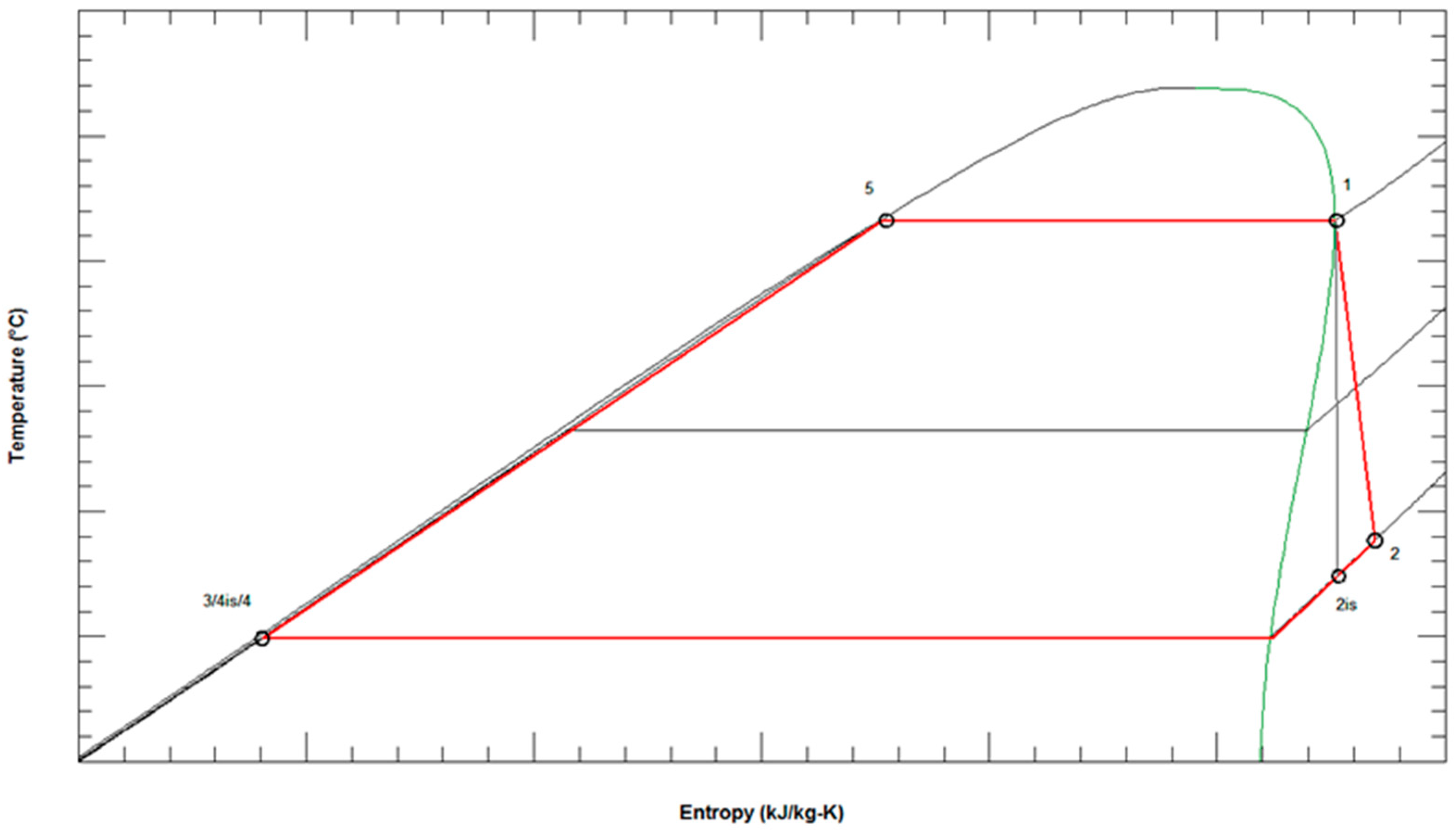
References
- Di Pippo, R. Geothermal Power Plants—Principles, Applications and Case Studies; Elsevier Ltd.: Oxford, UK, 2005. [Google Scholar]
- Gupta, H.; Roy, S. Geothermal Energy: An Alternative Resource for the 21st Century; Elsevier, B.V.: Amsterdam, The Netherlands, 2007. [Google Scholar]
- Available online: https://www.thinkgeoenergy.com (accessed on 25 March 2024).
- Lund, J.W.; Toth, A.N. Direct Utilization of Geothermal Energy 2020 Worldwide Review. In Proceedings of the World Geothermal Congress 2020, Reykjavik, Iceland, 24–27 October 2021. [Google Scholar]
- Bošnjak, R.; Čubrić, S.; Golub, M.; Grabovski, K.; Jelić, K.; Kolin, I.; Košćak, S.; Kulenović, I.; Mioćev, D.; Pravica, Z.; et al. A Program of Geothermal Energy Usage in the Republic of Croatia; Energy Institute “Hrvoje Požar”: Zagreb, Croatia, 1998. [Google Scholar]
- Guzović, Z.; Lončar, D.; Ferdelji, N. Possibilities of electricity generation in the Republic Croatia by means of geothermal energy. Energy 2010, 35, 3429–3440. [Google Scholar]
- Guzović, Z.; Majcen, B.; Cvetković, S. Possibilities of electricity generation in the Republic Croatia from medium temperature geothermal sources. Appl. Energy 2012, 98, 404–414. [Google Scholar] [CrossRef]
- Rašković, P.; Guzović, Z.; Cvetković, S. Performance analysis of electricity generation by the medium temperature geothermal resources: Velika Ciglena case study. Energy 2013, 54, 11–31. [Google Scholar] [CrossRef]
- Guzović, Z.; Martan, B.; Majcen, B. Possibilities of electricity generation in The Republic Croatia by means of low temperature geothermal sources. In Proceedings of the 21st International Symposium on Heating, Refrigerating and Air Conditioning, Zagreb, Croatia, 26–28 October 2011. [Google Scholar]
- Šoški, J. Steam Turbine for Geothermal Power Plant Rečica. Diploma Thesis, University of Zagreb, Faculty of Mechanical Engineering and Naval Architecture, Zagreb, Croatia, 2011. [Google Scholar]
- Davis, A.P.; Michaelides, E.E. Geothermal power production from abandoned oil wells. Energy 2009, 34, 866–872. [Google Scholar] [CrossRef]
- Gallup, D.L. Production engineering in geothermal technology: A review. Geothermics 2009, 38, 326–334. [Google Scholar]
- Clauser, C. Geothermal Energy; Group VIII—Advanced Materials and Technologies, Vol. 3: Energy Technologies, Subvol. C: Renewable Energies; Springer: Heidelberg/Berlin, Germany, 2006; pp. 493–604. [Google Scholar]
- Hettiarachchi, H.D.M.; Golubovic, M.; Worker, W.M.; Ikegami, Y. Optimum design criteria for an Organic Rankine cycle using low-temperature geothermal heat sources. Energy 2007, 32, 1698–1706. [Google Scholar]
- Rašković, P.; Stoiljković, S. Pinch design method in the case of a limited number of process streams. Energy 2009, 34, 593–612. [Google Scholar]
- Mlcak, H.A. An Introduction to the Kalina Cycle. In Proceedings of the International Joint Power Generation Conference, Houston, TX, USA, 13–17 October 1996. PWR-Vol. 30. [Google Scholar]
- Mlcak, H.A. Kalina cycle® concepts for low temperature geothermal. Geotherm. Resour. Counc. Trans. 2002, 26, 703–713. [Google Scholar]
- Valdimarsson, P. Geothermal power plant cycles and main components. In Proceedings of the Short Course on Geothermal Drilling, Resource Development and Power Plants, Santa Tecla, El Salvador, 16–22 January 2011; pp. 1–24. [Google Scholar]
- Ibrahim, O.M. Design considerations for ammonia-water Rankine cycle. Energy 1996, 21, 835–841. [Google Scholar]
- Lemmon, E.W.; Huber, M.L.; McLinden, M.O. Reference Fluid Thermodynamic and Transport Properties—REFPROP; NIST Standard, Reference Detabase 23, Version 8.0; Physical and Chemical Properties Division, U.S. Secretary of Commerce on Behalf of The United States of America: Washington, DC, USA, 2008. [Google Scholar]
- Di Pippo, R. Second Law assessment of binary plants generating power from low-temperature geothermal fluids. Int. J. Geotherm. 2004, 33, 565–586. [Google Scholar] [CrossRef]
- Tsatsaronis, G.; Cziesla, F. Thermoeconomics. In Encyclopedia of Physical Science and Technology; Elsevier: London, UK, 2002. [Google Scholar]
- Morosuk, T.; Tsatsaronis, G. New approach to the exergy analysis of absorption refrigeration machines. Energy 2008, 33, 890–907. [Google Scholar] [CrossRef]
- Bloomster, C.H.; Fassbender, L.L. The role of second law analysis in geothermal economics. Energy 1980, 5, 839–851. [Google Scholar] [CrossRef]
- Yari, M. Exergetic analysis of various types of geothermal power plants. Renew. Energy 2010, 35, 112–121. [Google Scholar] [CrossRef]
- Frick, S.; Kaltschmitt, M.; Schröder, G. Life cycle assessment of geothermal binary power plants using enhanced low-temperature reservoirs. Energy 2010, 35, 2281–2294. [Google Scholar] [CrossRef]
- Rašković, P.; Cvetković, S.; Stoiljković, S. Exergy analyse of CHP plant TE-TO Zrenjanin. In Proceedings of the 3rd Dubrovnik Conference on SDEWES, Dubrovnik, Croatia, 5–10 June 2005; pp. 518–530. [Google Scholar]
- Saleh, B.; Koglbauer, G.; Wendland, M.; Fischer, J. Working fluids for low-temperature organic Rankine cycles. Energy 2007, 32, 1210–1221. [Google Scholar] [CrossRef]
- Aghahosseini, S.; Dincer, I. Comparative performance analysis of low-temperature Organic Rankine Cycle (ORC) using pure and zeotropic working fluids. Appl. Therm. Eng. 2013, 54, 35–42. [Google Scholar] [CrossRef]
- Gianfranco, A.; Colonna di Paliano, P. Multicomponent Working Fluids for ORCs. Energy 1998, 23, 449–463. [Google Scholar]
- Tchanche, B.F.; Papadakis, G.; Lambrinos, G.; Frangoudakis, A. Fluid selection for a low-temperature solar organic Rankine cycle. Appl. Therm. Eng. 2009, 29, 2468–2476. [Google Scholar] [CrossRef]
- Delgado-Torres, A.M.; Garcia-Rodriguez, L. Analysis and optimization of the low-temperature solar organic Rankine cycle (ORC). Energy Convers. Manag. 2010, 51, 2846–2856. [Google Scholar] [CrossRef]
- Drescher, U.; Bruggemann, D. Fluid selection for the organic Rankine cycle (ORC) in biomass power and heat plants. Appl. Therm. Eng. 2007, 27, 223–228. [Google Scholar] [CrossRef]
- Liu, B.T.; Chien, K.H.; Wang, C.C. Effect of working fluids on organic Rankine cyclefor waste heat recovery. Energy 2004, 29, 1207–1217. [Google Scholar] [CrossRef]
- Borsukiewicz-Gozdur, A.; Nowak, W. Comparative analysis of natural and synthetic refrigerants in application to low temperature Clausisu-Rankine cycle. Energy 2007, 32, 344–352. [Google Scholar] [CrossRef]
- Hung, T.C.; Wang, S.K.; Kuo, C.H.; Pei, B.S.; Tsai, K.F. A study of organic working fluids on system efficiency of an ORC using low-grade energy sources. Energy 2010, 35, 1403–1411. [Google Scholar] [CrossRef]
- Chen, H.; Goswami, D.Y.; Stefanakos, E.K. A review of thermodynamic cycles and working fluids for the conversion of low-grade heat. Renew. Sustain. Energy Rev. 2010, 14, 3059–3067. [Google Scholar]
- Gawlik, K.; Hassaqni, V. Advanced Binary Cycles: Optimum working Fluids. In Proceedings of the Geothermal Resources Council 1998: Annual Meeting, San Diego, CA, USA, 20–23 September 1998. [Google Scholar]
- West, H.H.; Patton, J.M.; Starling, K.E. Selection of Working Fluids for The Organic Rankine Cycle. In Proceedings of the 1st Industrial Energy Technology Conference, Houston, TX, USA, 21–22 April 1979. [Google Scholar]
- Zhu, Q.; Sun, Z.; Zhou, J. Performance Analysis of Organic Rankine Cycles Using Different working Fluids. Therm. Sci. 2015, 19, 179–191. [Google Scholar]
- Kanoglu, M.; Cengel, Y.A. Economic evaluation of geothermal power generation, heating, and cooling. Energy 1999, 24, 501–509. [Google Scholar]
- Lakew, A.A.; Bolland, O. Working fluids for low-temperature heat source. Appl. Therm. Eng. 2010, 30, 1262–1268. [Google Scholar] [CrossRef]
- Invernizzi, C.; Iora, P.; Silva, P. Bottoming micro-Rankine cycles for micro-gas turbines. Appl. Therm. Eng. 2007, 27, 100–110. [Google Scholar] [CrossRef]
- Maizza, V.; Maizza, A. Unconvential working fluids in organic Rankine-cycles for waste energy recovery systems. Appl. Therm. Eng. 2001, 21, 381–390. [Google Scholar]
- Yamamoto, T.; Furuhata, T.; Arai, N.; Mori, K. Design and testing of the ORC. Energy 2001, 26, 239–251. [Google Scholar]
- Quoilin, S. Experimental Study and Modeling of a Low Temperature Rankine Cycle for Small Scale Cogeneration. Ph.D. Thesis, University of Liege, Liège, Belgium, 2007. [Google Scholar]
- Calderazzi, L.; di Paliano, P.C. Thermal stability of R-134, R-141b, R-1311, R-7146, R-125 associated with stainless steel as a containing material. Int. J. Refrig. 1997, 20, 381–389. [Google Scholar]
- Bao, J.; Zhao, L. A review of working fluid and expander selections for organic Rankine cycle. Renew. Sustain. Energy Rev. 2013, 24, 325–342. [Google Scholar] [CrossRef]

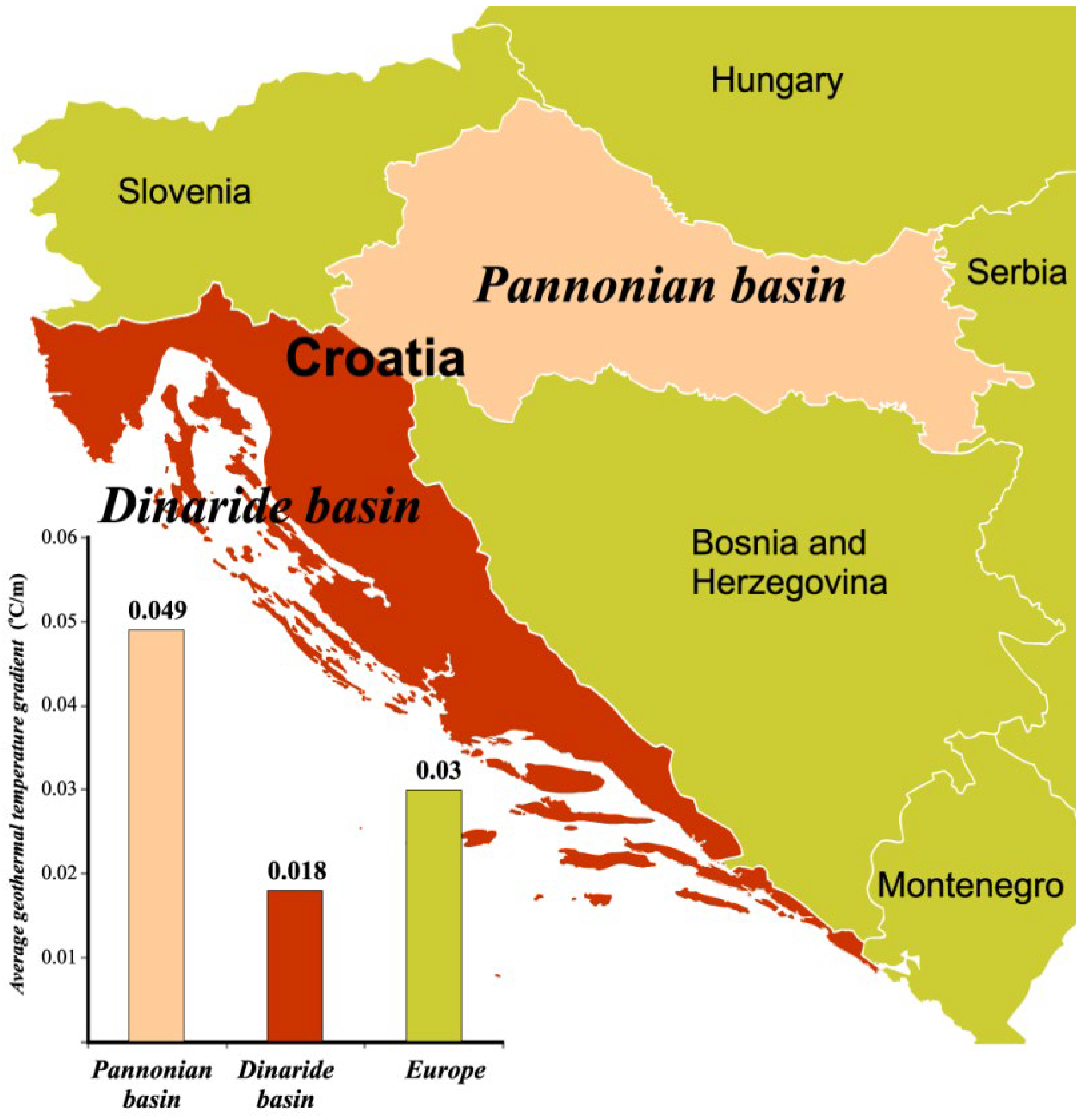

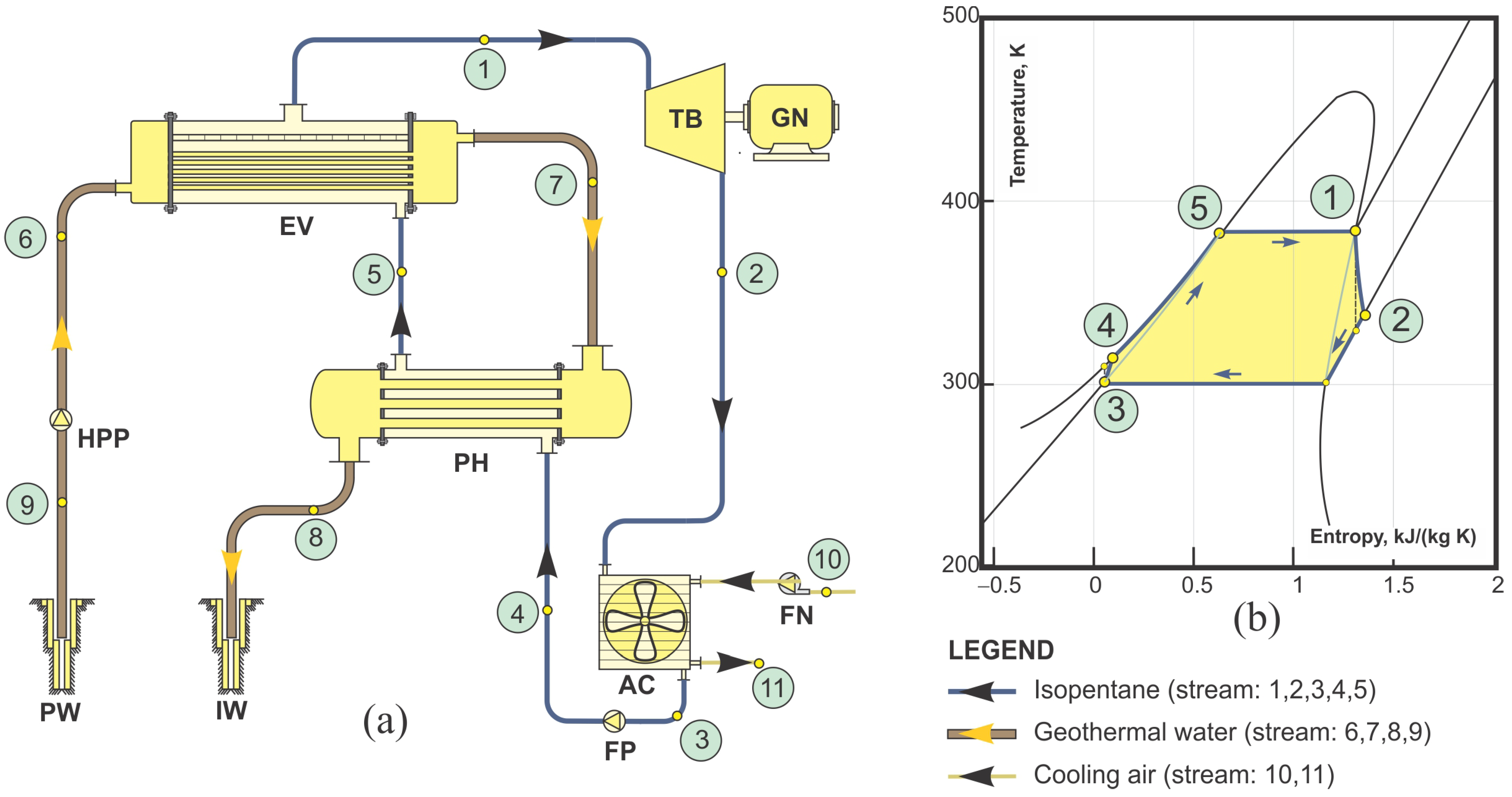
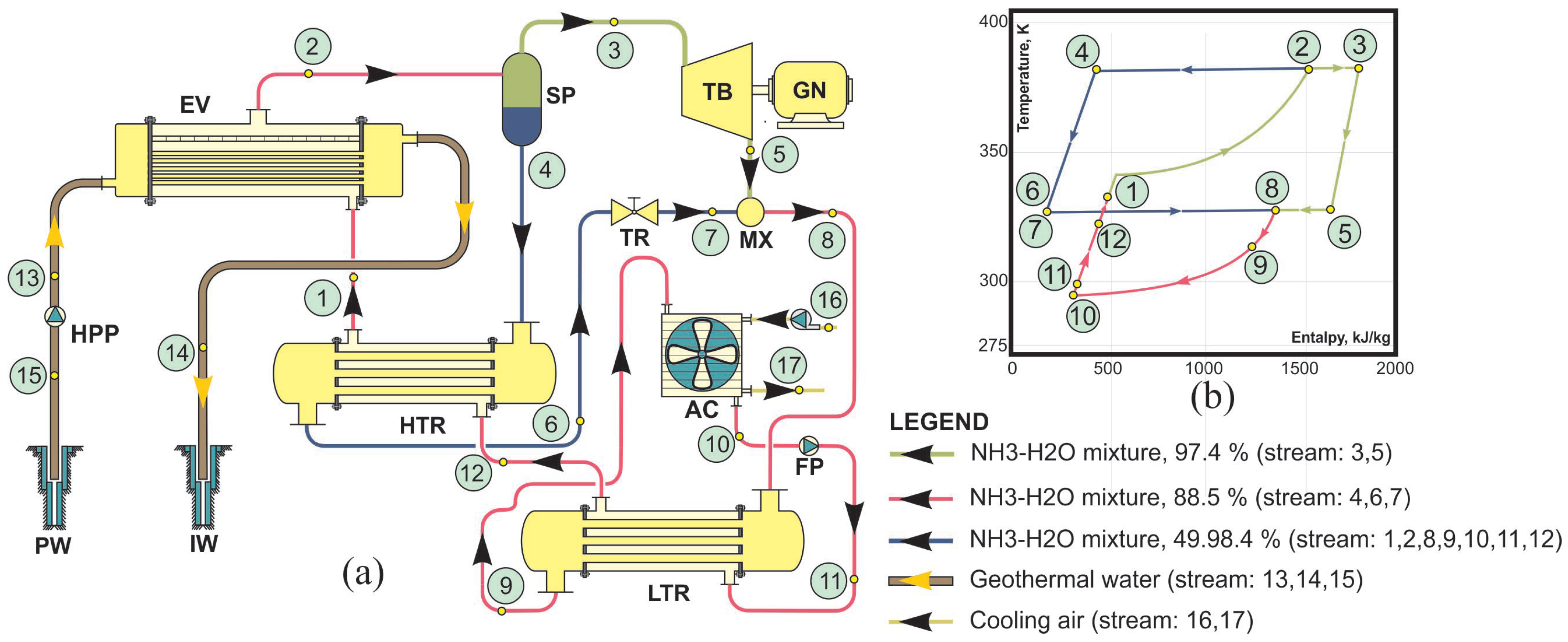
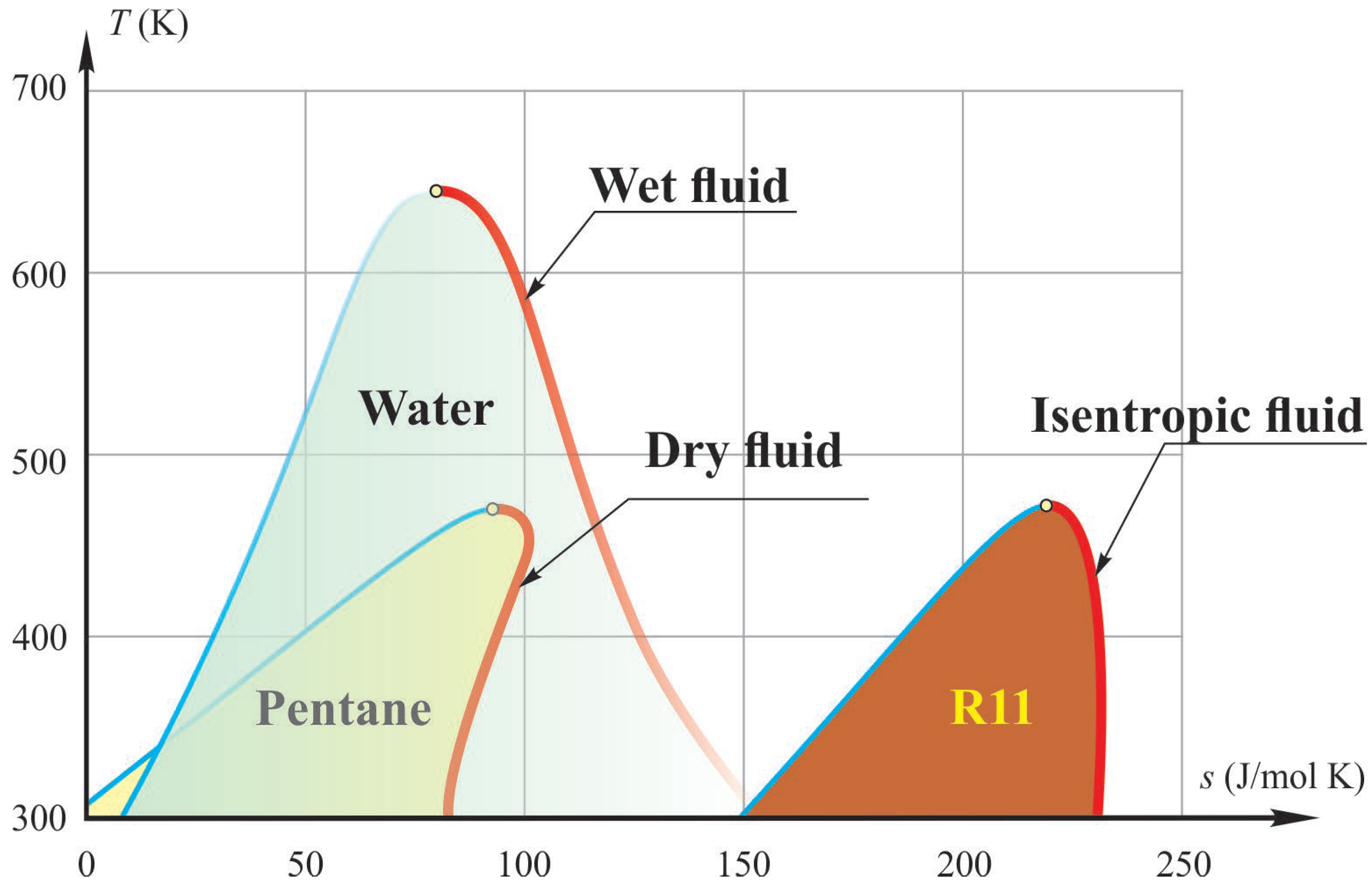
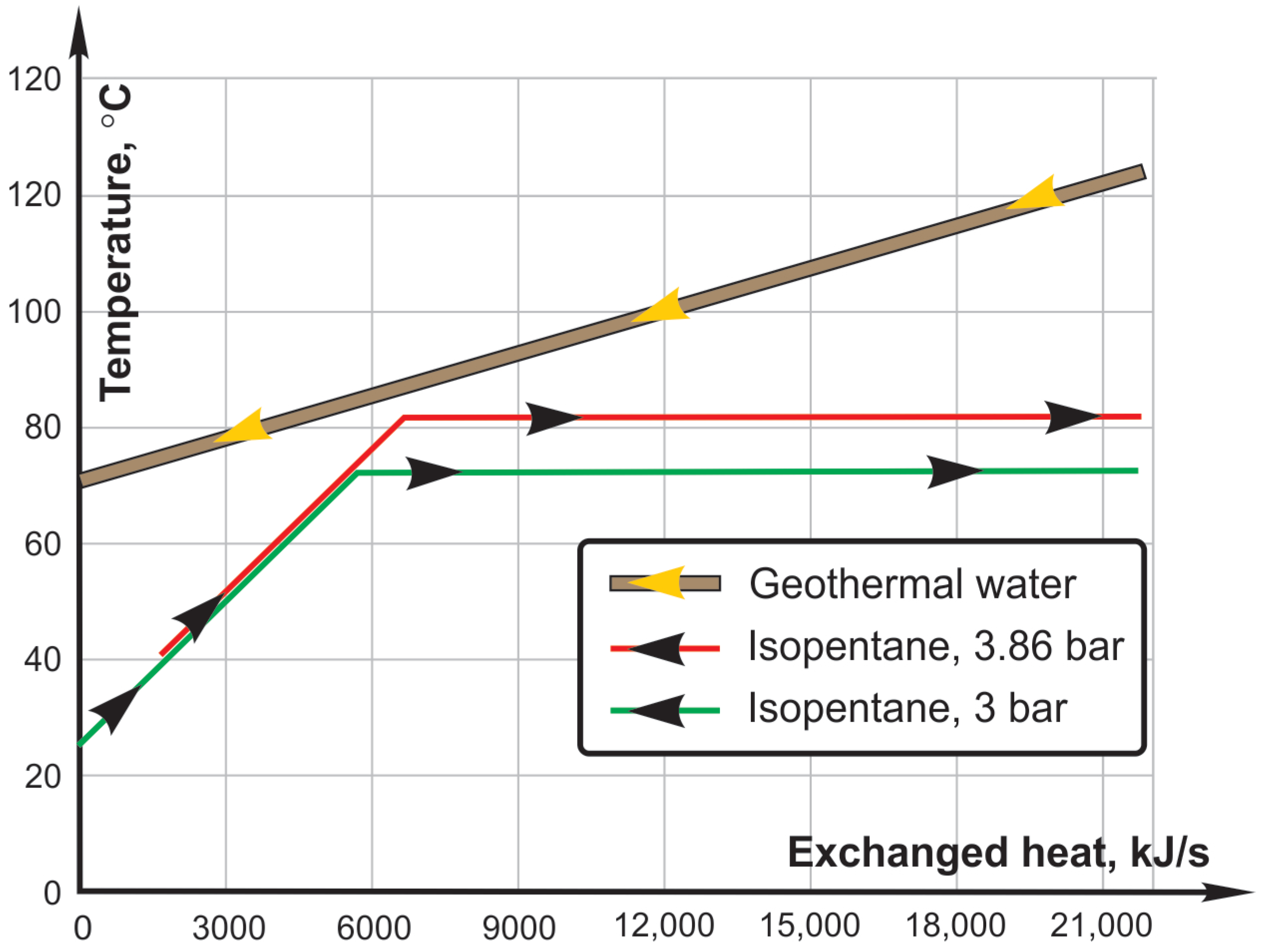
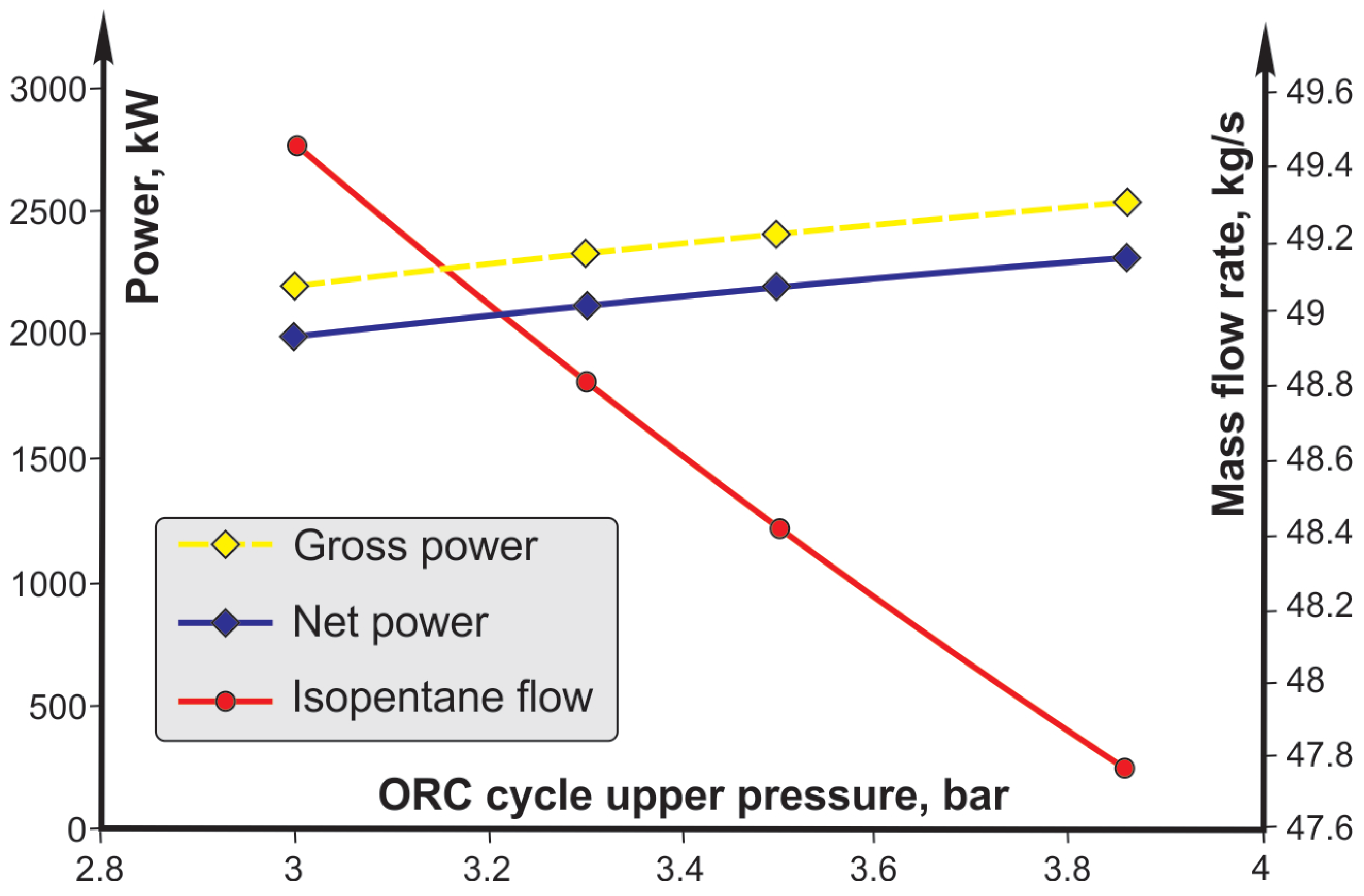
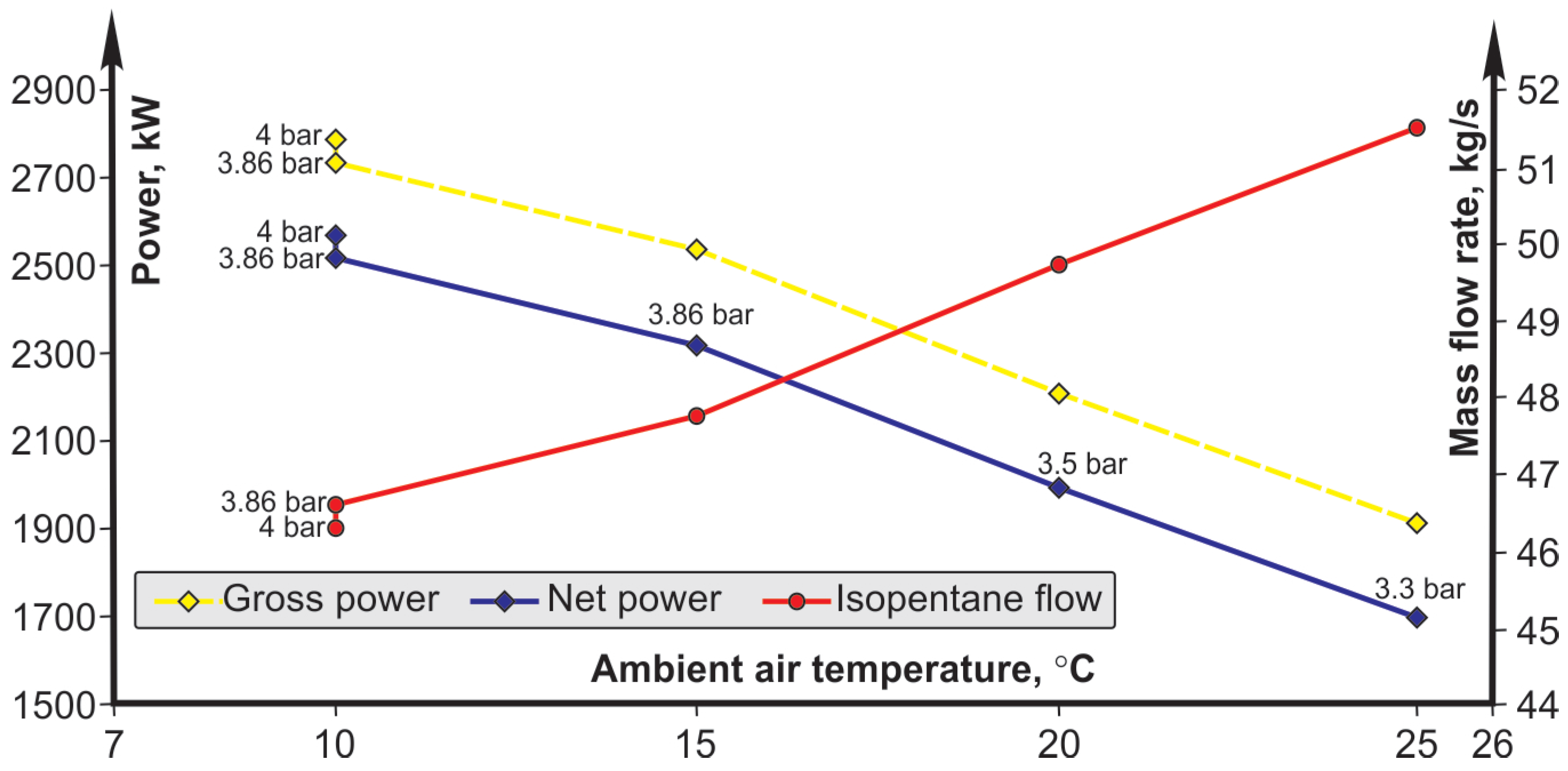
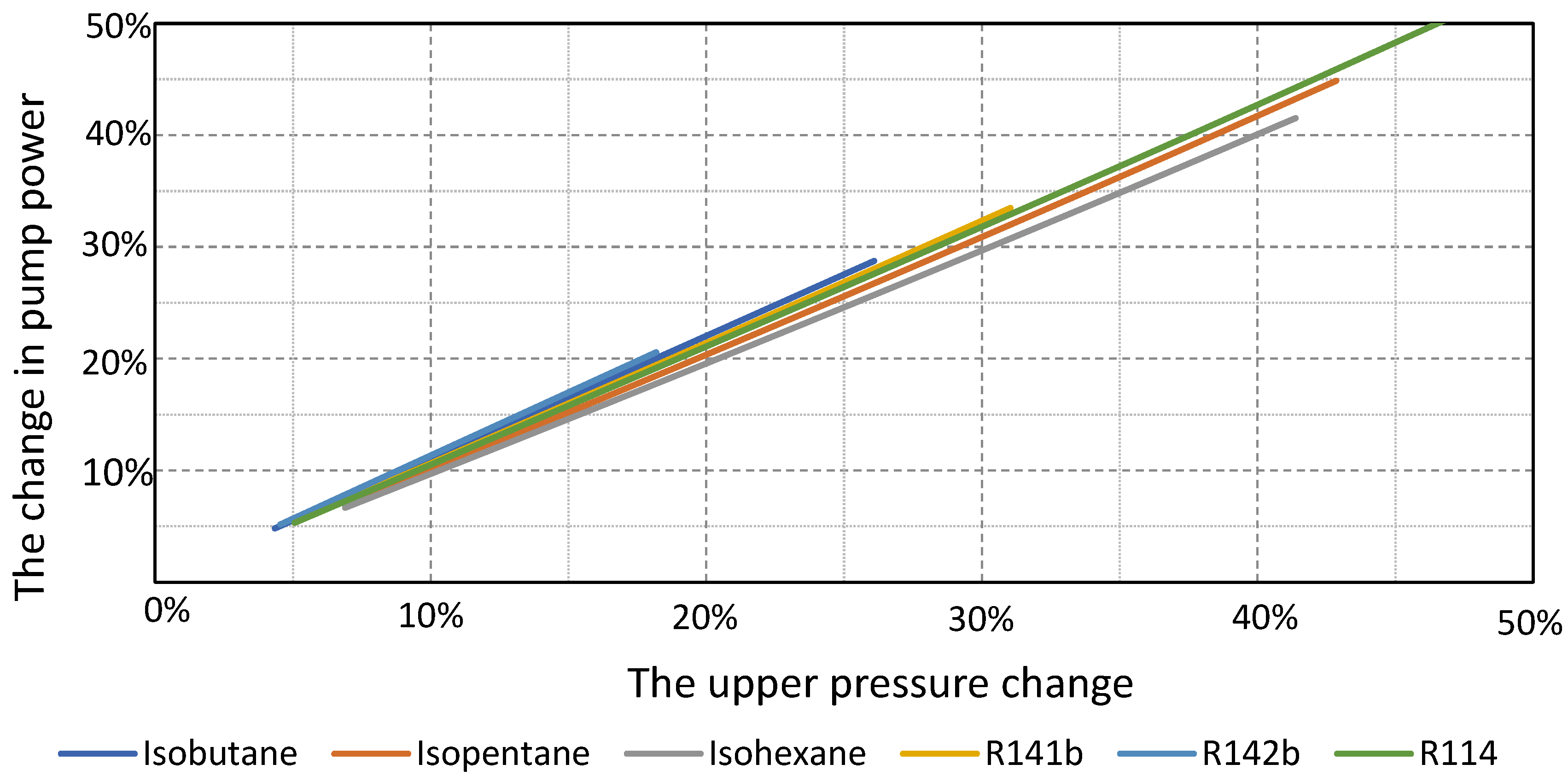



| Geothermal Field | Geothermal Fluid | Organic Rankine Cycle (ORC) | Kalina Cycle | ||||||
|---|---|---|---|---|---|---|---|---|---|
| Flow Rate [kg/s] | Input Temp. [°C] | Output Temp. [°C] | Cycle Net Power [kW] | 1st Law Effici. [%] | 2nd Law Effici. [%] | Cycle Net Power [kW] | 1st Law Effici. [%] | 2nd Law Effici. [%] | |
| Velika Ciglena | 83.0 | 170 | 69 | 5270 | 14.1 | 52 | 3949 | 10.6 | 44 |
| Lunjkovec- Kutnjak | 64.87 | 140 | 80 | 2225.5 | 13.5 | 46.2 | 2101.4 | 12.8 | 43 |
| Babina Greda | 93.97 | 125 | 70 | 2509.9 | 11.5 | 46.3 | 2317.4 | 10.7 | 42.7 |
| Rečica | 94.38 | 120 | 80 | 1964.1 | 12.4 | 35.9 | 1872.4 | 11.8 | 34.2 |
| Properties | Reason | |
|---|---|---|
| 1. | As low as possible dew point pressure at the point of initial condensation but greater than atmospheric pressure: |
|
| 2. | Nearly vertical saturated vapor line in a T-s diagram: |
|
| 3. | Large specific enthalpy drop in the turbine: |
|
| 4. | Reasonably low turbine inlet pressure: |
|
| 5. | A small heat of evaporation and a matching heat resource: |
|
| 6. | A low specific heat: |
|
| 7. | Small specific volume at the turbine exit (turbine size factor): |
|
| 8. | Large thermal conductivity coefficients: |
|
| 9. | Low viscosities: |
|
| 10. | Appropriate freezing point: |
|
| 11. | Sufficiently high boiling temperature under atmospheric pressure: |
|
| 12. | Chemical stable under working conditions: |
|
| 13. | Low both ODP and GWP: |
|
| 14. | A high flash point: |
|
| 15. | A low toxicity: |
|
| 16. | Low cost, essentially non-fouling, non-corrosive |
|
| Working Fluid | Physical Data | Safety Data- ASHRAE 34 Safety Group | Environmental Data | |||||
|---|---|---|---|---|---|---|---|---|
| Molecular Mass, M [kg/kmol] | Boiling Point, Tbp [°C] | Critical Point | ALT [yr] | ODP [-] | GWP [100 yr] | |||
| Tcrit [°C] | pcrit [MPa] | |||||||
| hexane | 86.18 | 68.71 | 234.67 | 3.034 | n.a. | n.a. | n.a. | n.a. |
| R114 | 170.92 | 3.6 | 145.7 | 3.257 | A1 | 300 | 1 | 10,000 |
| R142b | 100.5 | −9.12 | 137.11 | 4.06 | A2 | 17.9 | 0.07 | 2310 |
| R141b | 116.95 | 32.05 | 204.35 | 4.212 | A2 | 9.3 | 0.12 | 725 |
| R600a | 58.12 | −11.7 | 134.7 | 3.63 | A3 | 12 ± 3 | 0 | 4 |
| R601a | 72.1 | 27.8 | 187.2 | 3.78 | A3 | 12 ± 3 | 0 | 4 ± 2 |
| Working Fluid | Performances of ORC | |||||||||
|---|---|---|---|---|---|---|---|---|---|---|
| Type of Working Fluid | Cycle Net Power, [kW] | Mass Flow of Working Fluid, [kg/s] | 1st Law (2nd Law) Efficien., [%] | [kW] | [kW] | [kW] | Heat Rejected, [kW] | Upper Pressure, [bar] | Lower Pressure, [bar] | |
| hexane | dry | 2227.46 | 35.13 | 12.56 (37.97) | 2068.12 | 17.72 | 141.61 | 14,250.48 | 2.9 | 0.3 |
| R114 | dry | 2099.55 | 97.08 | 12.76 (35.79) | 2354.61 | 113.75 | 141.30 | 14,219.36 | 15.8 | 2.1 |
| R142b | isentropic | 2129.37 | 68.64 | 12.94 (36.30) | 2413.88 | 143.51 | 141.01 | 14,189.83 | 22.0 | 3.4 |
| R141b | isentropic | 2093.71 | 60.64 | 12.72 (35.69) | 2265.87 | 30.80 | 141.36 | 14,225.14 | 5.8 | 0.8 |
| R600a- isobutane | dry | 2135.21 | 39.26 | 12.97 (36.40) | 2449.44 | 173.29 | 140.95 | 14,184.05 | 23.0 | 3.5 |
| R601a- isopentane | dry | 2077.32 | 35.89 | 12.62 (35.41) | 2263.19 | 44.34 | 141.52 | 14,241.37 | 7.0 | 0.9 |
Disclaimer/Publisher’s Note: The statements, opinions and data contained in all publications are solely those of the individual author(s) and contributor(s) and not of MDPI and/or the editor(s). MDPI and/or the editor(s) disclaim responsibility for any injury to people or property resulting from any ideas, methods, instructions or products referred to in the content. |
© 2025 by the authors. Licensee MDPI, Basel, Switzerland. This article is an open access article distributed under the terms and conditions of the Creative Commons Attribution (CC BY) license (https://creativecommons.org/licenses/by/4.0/).
Share and Cite
Guzović, Z.; Bačelić Medić, Z.; Budanko, M. Effect of Working Fluid on Characteristics of Organic Rankine Cycle with Medium Temperature Geothermal Water. Energies 2025, 18, 1699. https://doi.org/10.3390/en18071699
Guzović Z, Bačelić Medić Z, Budanko M. Effect of Working Fluid on Characteristics of Organic Rankine Cycle with Medium Temperature Geothermal Water. Energies. 2025; 18(7):1699. https://doi.org/10.3390/en18071699
Chicago/Turabian StyleGuzović, Zvonimir, Zlatko Bačelić Medić, and Marina Budanko. 2025. "Effect of Working Fluid on Characteristics of Organic Rankine Cycle with Medium Temperature Geothermal Water" Energies 18, no. 7: 1699. https://doi.org/10.3390/en18071699
APA StyleGuzović, Z., Bačelić Medić, Z., & Budanko, M. (2025). Effect of Working Fluid on Characteristics of Organic Rankine Cycle with Medium Temperature Geothermal Water. Energies, 18(7), 1699. https://doi.org/10.3390/en18071699






